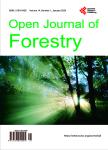Resin Production in Natural and Artificial Red-Cockaded Woodpecker Cavity Trees
Resin Production in Natural and Artificial Red-Cockaded Woodpecker Cavity Trees作者机构:Arthur Temple College of Forestry and Agriculture Stephen F. Austin State University Nacogdoches TX USA School of Forestry Louisiana Tech University Rustin LA USA U. S. Department of Agriculture Forest Service (Retired) Southern Research Station Nacogdoches TX USA
出 版 物:《Open Journal of Forestry》 (林学期刊(英文))
年 卷 期:2015年第5卷第4期
页 面:364-374页
学科分类:1002[医学-临床医学] 100214[医学-肿瘤学] 10[医学]
主 题:Endangered Species Red-Cockaded Woodpecker Resin Sampling Super Resin Producers Cavity Trees
摘 要:Resin flow was measured in red-cockaded woodpecker (Picoides borealis Vieillot) clusters in longleaf pine (Pinus palustris Mill.) in the southern region of the Angelina National Forest, Texas. Resin flow (ml) at 1.4 m height over 24 hrs was measured from one 2.5 cm punch through the phloem between 0700 and 1000 hrs from March 1999 to September 2000, for a total of 9 measurements per tree. Resin was sampled in naturally active cavity trees, artificial (insert) active, natural inactive, artificial inactive and control pines (84 sample trees). Resin flow pattern was significantly different during the year, but not significantly different in the cavity tree type resin flow. Cavity trees in the 90th percentile (33.0 ml resin in 24 hrs) were defined as super resin producing. High average resin flows in August 1999 and September 2000 indicate when to sample resin for potential cavity trees. Regression equations were produced to estimate future resin production.



